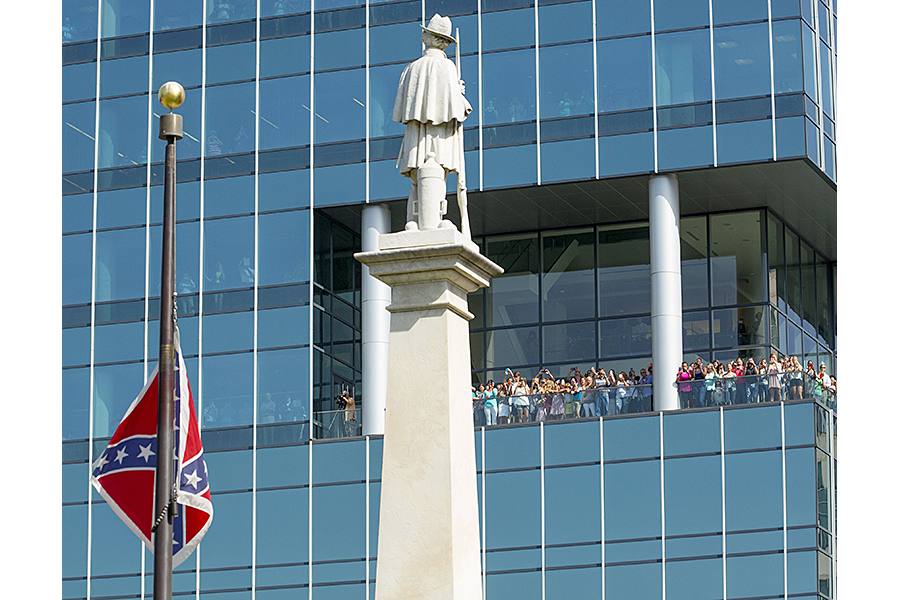In an amazing arc of grace, Confederate battle flag finally furled
| Atlanta
It had flown, unrelenting, for 54 years on the State House grounds in Columbia, S.C., a Confederate battle flag celebrated by many as the distilled spirit of the South, but with a legacy so horrific to many black people and others that it gave them chills just to be near it.
On Friday, the Confederate battle flag, after a brief ceremony, came down amid cheers, even as some Southerners hung their heads, unbelieving that a flag they believe represents solely the valor of Southern soldiers defending their land had come to represent hatred and oppression.
But it had, powerfully – long before a white supremacist who posed with rebel flags killed nine black parishioners, including state Sen. Clementa Pinckney, on June 17 in Charleston, S.C.
The shock of the murders and the massacre site – a historic church – united South Carolinians under a banner of grace, as Charlestonians joined hands to pray and mourn. President Obama referenced the biblical idea of grace – defined in part as a divine influence of goodness upon people – as a uniting force, even as he sang the spiritual hymn “Amazing Grace” at the Reverend Pinckney’s funeral.
And so the shootings’ aftermath will be remembered not for rancor and division, but for an amazing display of love and unity of purpose, which became focused on the flag’s star-studded, tipped-over cross.
In comments made Friday, the Rev. Jesse Jackson likened the church shootings as the crucifixion and the taking down of the flag as the resurrection.
“It’s hard to downplay the significance of this really monumental event, that a state so wedded to history and its symbols voted pretty overwhelmingly to take this flag down and put it in a museum,” says Gibbs Knotts, a political scientist at the College of Charleston.
The call for the flag to come down marked a turning point not only for Republican Gov. Nikki Haley, a past flag defender who pleaded for the legislature to take it down, but also for many white Southerners. Indeed, it was largely white South Carolinians, including GOP lawmakers, who pushed for the flag’s removal, The State newspaper pointed out Friday.
“This happened because people looked with new hearts and eyes and minds on the flag and on their fellow citizens and decided that it must happen,” the newspaper’s editorial board wrote.
But it didn’t come easily. After the state Senate, which had seen one of its own lost in the Charleston mayhem, quickly passed a bill earlier in the week, South Carolina’s famously rancorous House began on Wednesday what became 13 hours of deliberation. When the political winds suggested that the vote should be delayed, Jenny Horne, a descendant of Confederate President Jefferson Davis, took to the floor, tearful, to chastise what she called her “friends.”
"I cannot believe that we do not have the heart in this body to do something meaningful, such as take a symbol of hate off these grounds on Friday,” she argued, at times sobbing.
The measure passed shortly afterward. Governor Haley signed the bill into law on Thursday, and state police immediately cordoned the flag off to prepare for the removal ceremony.
In the war, the banner served as the battle flag for the Army of Northern Virginia, and then it was a museum piece for 100 years. In the 1950s and ’60s, white segregationists brought the flag back, as it became a symbol of the insurgent Dixiecrat party, led by the late South Carolina Sen. Strom Thurmond.
Flown in 1961 commemorate the 100-year anniversary of the start of the Civil War, the flag stayed up in protest of the civil rights movement. It was then that federal lawmakers and judges began to dismantle Jim Crow, the informal political system in the South that marginalized blacks and forced them, among other things, to drink out of separate water fountains.
In the modern era, the flag had come to symbolize Southern-fried rebellion – a quaint, youthful symbol that pop culture often treated with hilarity. But some 30 years after “The Dukes of Hazzard,” with its Confederate flag-emblazoned “General Lee” Dodge Charger, dominated the ratings, cable channel TV Land pulled reruns of the show after the Charleston massacre.
On Friday, South Carolina lawmakers and relatives of the victims of the Charleston shootings watched somberly as an honor guard removed the flag and folded it. Throngs of people who were assembled to watch yelled, "Take it down! Take it down!"
For all the heartache and wrenching debate over the past three weeks, the furling of the Confederate flag and its removal to what will become a multimillion-dollar shrine at South Carolina’s “relic room” in Columbia suggested a new beginning for a state long bogged down by racial divides.
“This moment is about more than a flag or a vote. It’s about the hope that now, 150 years after the end of the Civil War, we have grown beyond our differences and have begun to grow together,” Columbia Mayor Steve Benjamin tweeted.
Before the flag came down, Haley said on NBC’s “Today” show, “I don't want this to go away quickly. I want people to remember what today feels like and know that anything is possible with us."






